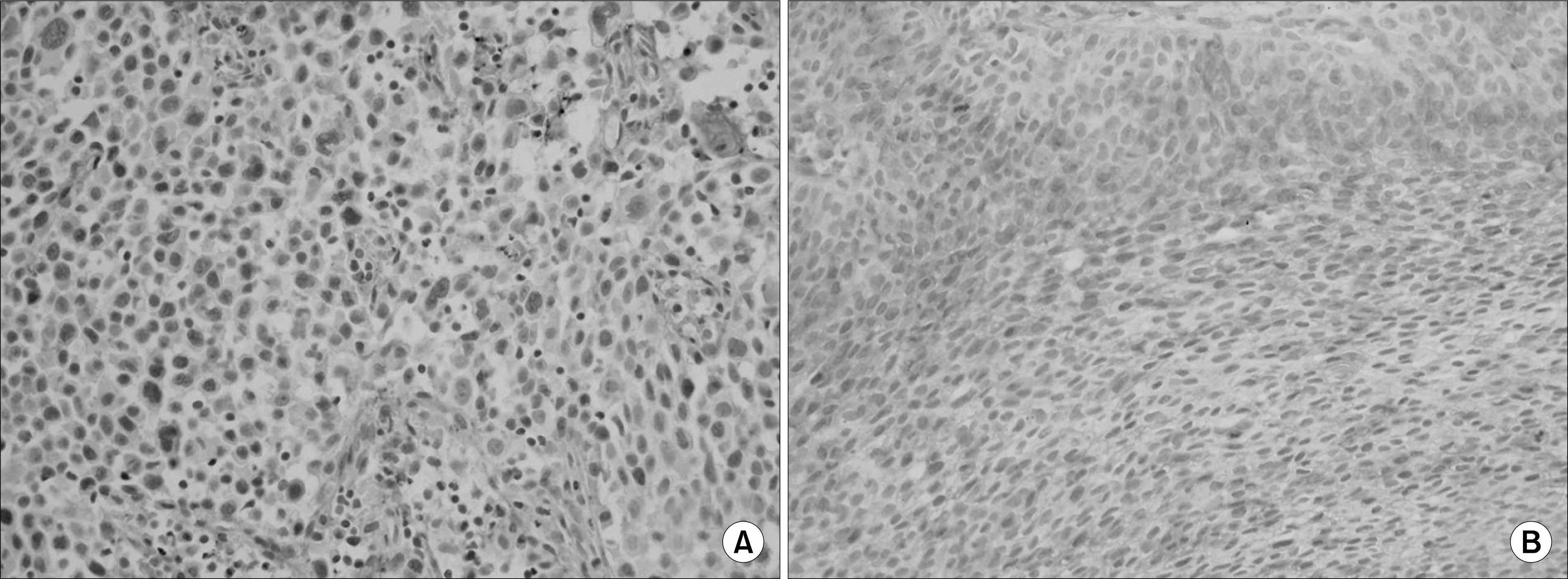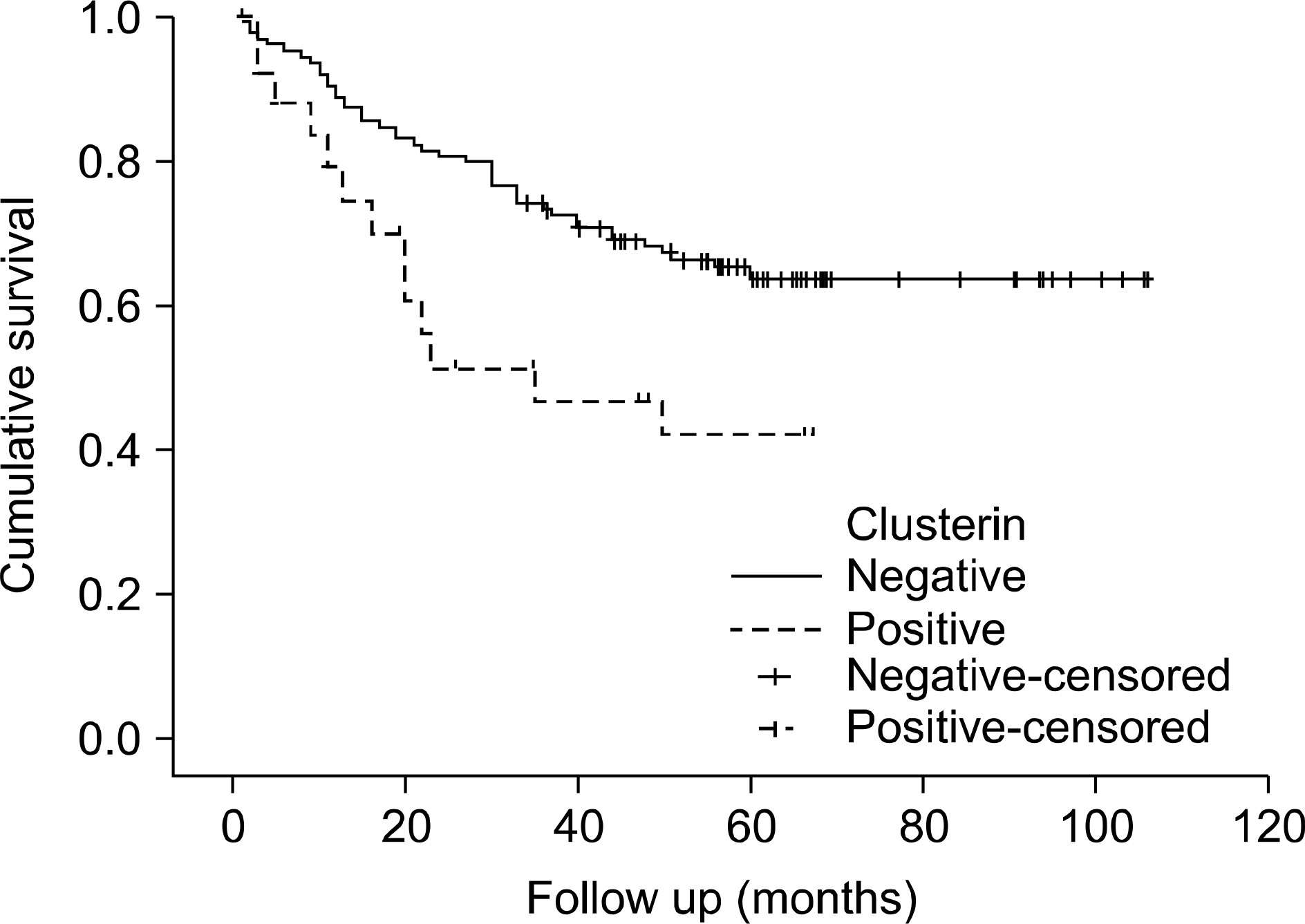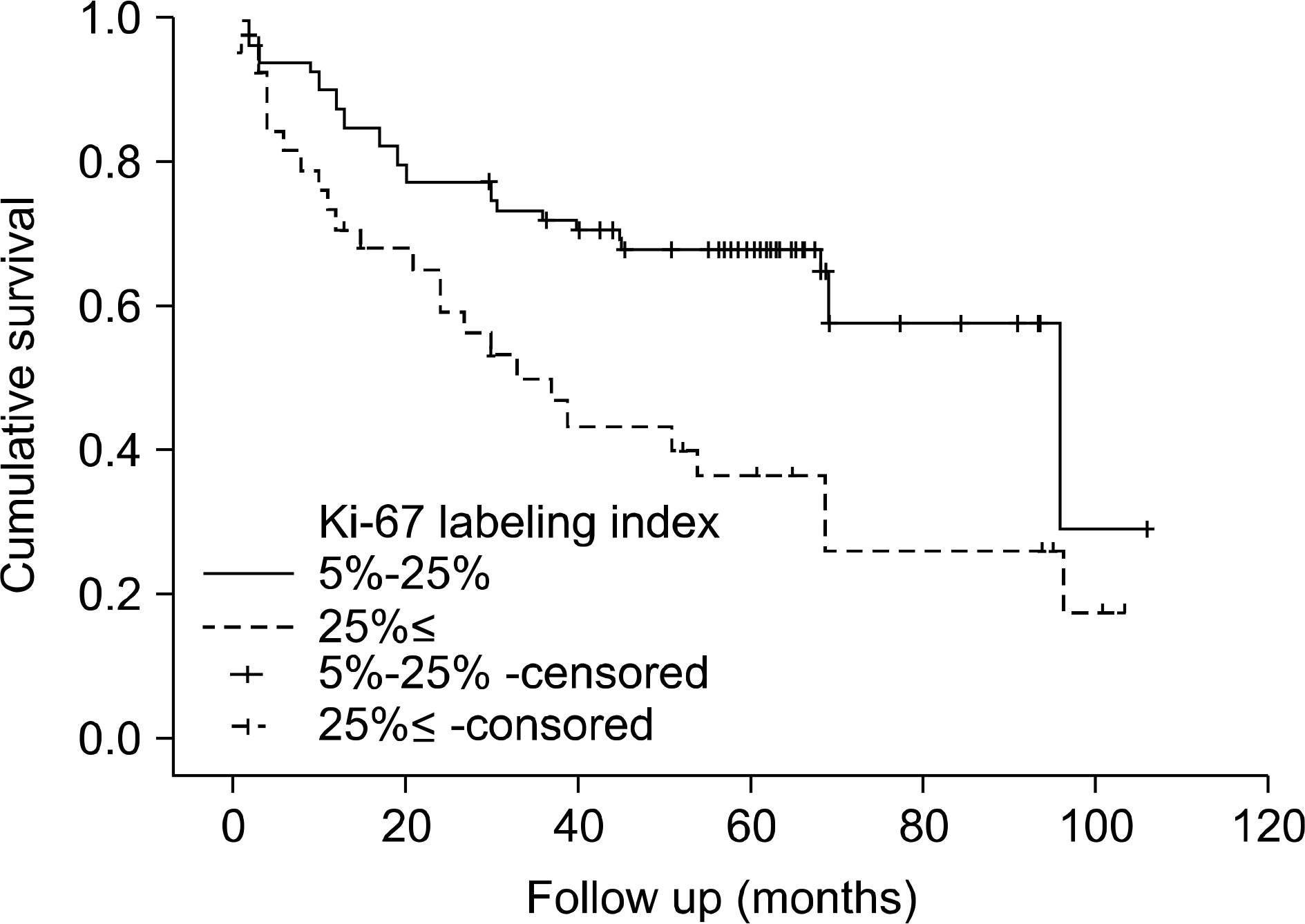Korean J Urol.
2008 Aug;49(8):688-695.
The Relationship of Clusterin Expression and Ki-67 Labeling Index with Clinicopathologic Factors in Human Transitional Cell Carcinoma
- Affiliations
-
- 1Departments of Urology, College of Medicine, Pusan National University, Busan, Korea.toohotman@hanmail.net
- 2Departments of Pathology, College of Medicine, Pusan National University, Busan, Korea.
Abstract
-
PURPOSE: This study examined the expression of clusterin and Ki-67 in human transitional cell carcinoma(TCC). In addition, the relationship of clusterin and Ki-67 expression with the clinicopathological factors and prognosis of human TCC was investigated.
MATERIALS AND METHODS
149 human TCC tissues were obtained from 149 patients who underwent a radical cystectomy(n=81) or transurethral resection(n=68). The expression of clusterin and Ki-67 was analyzed using immunohistochemical staining. The results were evaluated with respect to the clinicopathological factors.
RESULTS
Positive clusterin expression was observed in 21.1% of the total TCC tissues. The expression of clusterin was not significantly related to age, gender, tumor stage and grade. However, recurrence-free survival rate of the patients with positive clusterin expression was significantly lower than that of patients with negative clusterin expression(p=0.02). The expression level of Ki-67 in the TCC tissues was associated with the tumor stage(p<0.001) and grade(p<0.001), but not with age and gender. Furthermore, the recurrence-free survival rate of patients with strong Ki-67 expression was significantly lower than that of patients with weak Ki-67 expression(p<0.001). The expression of clusterin was not significantly related to the level of Ki-67 expression. However, in the patients showing strong Ki-67 expression, the recurrence-free survival rate of the patients with positive clusterin expression was significantly lower than that of the patients with negative clusterin expression(p<0.001).
CONCLUSIONS
These results suggest that the expression of clusterin and Ki-67 can be used as a useful predictor of the prognosis of patients with human TCC.
Keyword
Figure
Reference
-
1.Joung JY., Seo HK., Chung JS., Hwang HS., Hong EK., Lee KH. Clinical efficacy of Ki-67, apoptotic index, bcl-2, and p53 in bladder tumor: correlation with stage, histologic grade and recurrence rate. Korean J Urol Oncol. 2003. 1:376–81.2.Weinberg RA. Oncogenes, antioncogenes, and the molecular bases of multistep carcinogenesis. Cancer Res. 1989. 49:3713–21.3.Sylvester SR., Morales C., Oko R., Griswold MD. Localization of sulfated glycoprotein-2 (clusterin) on spermatozoa and in the reproductive tract of the male rat. Biol Reprod. 1991. 45:195–207.4.Fritz IB., Burdzy K., Setchell B., Blaschuk O. Ram rete testis fluid contains a protein (clusterin) which influences cell-cell interactions in vitro. Biol Reprod. 1983. 28:1173–88.5.Parczyk K., Pilarsky C., Rachel U., Koch-Brandt C. Gp80 (clusterin; TRPM-2) mRNA level is enhanced in human renal clear cell carcinomas. J Cancer Res Clin Oncol. 1994. 120:186–8.
Article6.Sensibar JA., Sutkowski DM., Raffo A., Buttyan R., Griswold MD., Sylvester SR, et al. Prevention of cell death induced by tumor necrosis factor alpha in LNCaP cells by overexpression of sulfated glycoprotein-2 (clusterin). Cancer Res. 1995. 55:2431–7.7.Leskov KS., Klokov DY., Li J., Kinsella TJ., Boothman DA. Synthesis and functional analyses of nuclear clusterin, a cell death protein. J Biol Chem. 2003. 278:11590–600.
Article8.Kruger S., Mahnken A., Kausch I., Feller AC. Value of clusterin immunoreactivity as a predictive factor in muscle-invasive urothelial bladder carcinoma. Urology. 2006. 67:105–9.
Article9.Miyake H., Gleave M., Kamidono S., Hara I. Overexpression of clusterin in transitional cell carcinoma of the bladder is related to disease progression and recurrence. Urology. 2002. 59:150–4.
Article10.Yoon JH., Lee JH., Yeom BW., Won NH., Yoon DK. Expression of osteopontin and clusterin in transitional cell carcinoma of the bladder: comparison to the pathologic stage. Korean J Urol. 2005. 46:341–6.11.Park HJ., Lee HJ., Yum YH., Kang JY., Yoo TK. Clusterin expression and apoptosis in transitional cell carcinoma of the bladder. Korean J Urol. 2007. 48:402–7.
Article12.Mellon K., Neal DE., Robinson MC., Marsh C., Wright C. Cell cycling in bladder carcinoma determined by monoclonal antibody Ki67. Br J Urol. 1990. 66:281–5.
Article13.Lakins J., Bennett SA., Chen JH., Arnold JM., Morrissey C., Wong P, et al. Clusterin biogenesis in altered during apoptosis in the regressing rat ventral prostate. J Biol Chem. 1998. 273:27887–95.14.Pucci S., Bonanno E., Pichiorri F., Angeloni C., Spagnoli LG. Modulation of different clusterin isoforms in human colon tumorigenesis. Oncogene. 2004. 23:2298–304.
Article15.July LV., Beraldi E., So A., Fazli L., Evans K., English JC, et al. Nucleotide-based therapies targeting clusterin chemosen-sitize human lung adenocarcinoma cells both in vitro and in vivo. Mol Cancer Ther. 2004. 3:223–32.16.Zellweger T., Kiyama S., Chi K., Miyake H., Adomat H., Skov K, et al. Overexpression of the cytoprotective protein clusterin decreases radiosensitivity in the human LNCaP prostate tumour model. BJU Int. 2003. 92:463–9.
Article17.Scaltriti M., Brausi M., Amorosi A., Caporali A., D'Arca D., Astancolle S, et al. Clusterin (SGP-2, ApoJ) expression is downregulated in low- and high-grade human prostate cancer. Int J Cancer. 2004. 108:23–30.
Article18.Miyake H., Hara S., Zellweger T., Kamidono S., Gleave ME., Hara I. Acquisition of resistance to Fas-mediated apoptosis by overexpression of clusterin in human renal-cell carcinoma cells. Mol Urol. 2001. 5:105–11.
Article19.Steinberg J., Oyasu R., Lang S., Sintich S., Rademaker A., Lee C, et al. Intracellular levels of SGP-2 (clusterin) correlate with tumor grade in prostate cancer. Clin Cancer Res. 1997. 3:1707–11.20.Kurahashi T., Muramaki M., Yamanaka K., Hara I., Miyake H. Expression of the secreted form of clusterin protein in renal cell carcinoma as a predictor of disease extension. BJU Int. 2005. 96:895–9.
Article21.Miyake H., Hara I., Kamidono S., Gleave ME. Synergistic chemsensitization and inhibition of tumor growth and meta-stasis by the antisense oligodeoxynucleotide targeting clusterin gene in a human bladder cancer model. Clin Cancer Res. 2001. 7:4245–52.22.Gerdes J., Schwab U., Lemke H., Stein H. Production of a mouse monoclonal antibody reactive with a human nuclear antigen associated with cell proliferation. Int J Cancer. 1983. 31:13–20.
Article23.Burger PC., Shibata T., Kleihues P. The use of the monoclonal antibody Ki-67 in the identification of proliferating cells: application to surgical neuropathology. Am J Surg Pathol. 1986. 10:611–7.
Article24.Cohen MB., Waldman FM., Carroll PR., Kerschmann R., Chew K., Mayall BH. Comparison of five histopathologic methods to assess cellular proliferation in transitional cell carcinoma of the urinary bladder. Hum Pathol. 1993. 24:772–8.
Article25.Okamura K., Miyake K., Koshikawa T., Asai J. Growth fractions of transitional cell carcinomas of the bladder defined by the monoclonal antibody Ki-67. J Urol. 1990. 144:875–8.
Article26.Oosterhuis JW., Schapers RF., Janssen-Heijnen ML., Smeets AW., Pauwels RP. MIB-1 as a proliferative marker in transitional cell carcinoma of the bladder: clinical significance and comparison with other prognostic factors. Cancer. 2000. 88:2598–605.27.Asakura T., Takano Y., Iki M., Suwa Y., Noguchi S., Kubota Y, et al. Prognostic value of Ki-67 for recurrence and progression of superficial bladder cancer. J Urol. 1997. 158:385–8.
Article28.Park HC., Kim JM., Lee CL., Lee W., Lee SD., Lee JZ, et al. The relationship of clusterin expression with Ki-67 expression and clinicopathological factors in human renal cell carcinoma. Korean J Urol. 2007. 48:244–51.
Article
- Full Text Links
- Actions
-
Cited
- CITED
-
- Close
- Share
- Similar articles
-
- The Relationship of Clusterin Expression with Ki-67 Expression and Clinicopathological Factors in Human Renal Cell Carcinoma
- Cell proliferation of transitional cell carcinoma of the bladder measured bu monoclonal antibody Ki-67
- Clusterin Expression and Apoptosis in Transitional Cell Carcinoma of the Bladder
- Correlation of Clinical Stage and Presumptive Prognostic Factors in Renal Cell Carcinoma
- Expression of Osteopontin and Clusterin in Transitional Cell Carcinoma of the Bladder: Comparison to the Pathologic Stage






